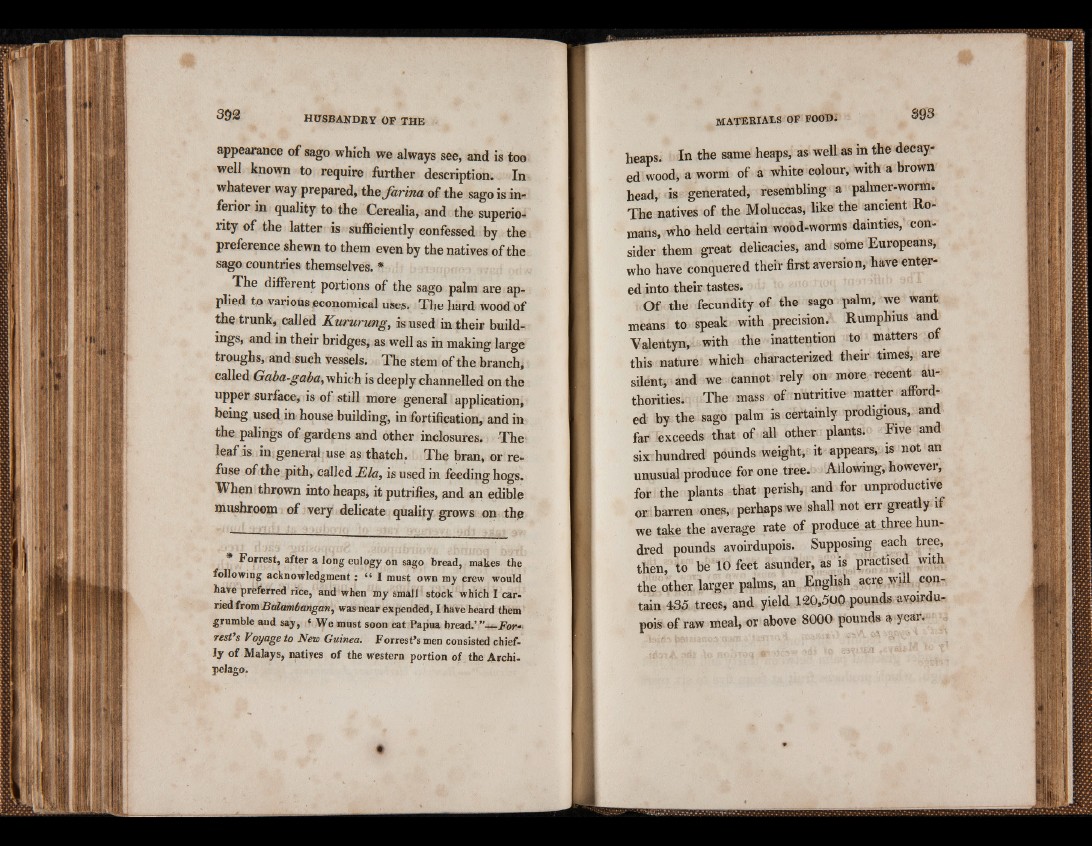
appearance of sago which we always see, and is too
well known to require further description. In
whatever way prepared, the farina of the sago is inferior
in quality to the Cerealia, and the superiority
of the latter is sufficiently confessed by the
preference shewn to them even by the natives of the
sago countries themselves. *
The different portions of the sago palm are applied
to various economical uses. The hard wood of
the trunk, called Kururung, is used in their buildings,
and in their bridges, as well as in making large
troughs, and such vessels. The stem of the branch,
called Gaba-gaba, which is deeply channelled on the
upper surface, is of still more general application,
being used in house building, in fortification, and in
the palings of gardens and other inclosures. The
leaf is in: general use as thatch. The bran, or refuse
of the pith, called Ela, is used in feeding hogs.
When thrown into heaps, it putrifies, and an edible
mushroom of very delicate quality grows on the
* Forrest, after a long eulogy on sago bread, makes the
following acknowledgment; 44 I must own my crew would
have preferred rice, and when my small stock which I carried
fromBaLambangan, was near expended, I have heard them
grumble aud say, 4 We must soon eat Papua bread.’ ”-—Forrest’s
Voi/age to New Guinea. Forrest’s men consisted chiefly
of Malays, natives of the western portion of the Archipelago.
t
heaps. In the same heaps, as well as in the decayed
wood, a worm of a white colour, with a brown
head, is generated, resembling a palmer-worm.
The natives of the Moluccas, like the ancient Romans,
who held certain wood-worms dainties, consider
them great delicacies, and some Europeans,
who have conquered their first aversion, have entered
into their tastes.
Of the fecundity of the sago palm, we want
means to speak with precision. Rumphius and
Valentyn, with the inattention to matters or
this nature which characterized their times, are
silent, and we cannot rely on more recent authorities.
The mass of nutritive matter afforded
by the sago palm is certainly prodigious, and
far exceeds that of all other plants. Five and
six hundred pounds weight, it appears, is not an
unusual produce for one tree. . Allowing, however,
for the plants that perish, and for unproductive
or , barren ones, perhaps we shall not err greatly if
we take the average rate of produce at three hundred
pounds avoirdupois. Supposing each tree,
then, to be 10 feet asunder, as is practised with
the other larger palms, an English acre >yill contain
435 trees, and y i e l d 120,500 pounds aw d u -
pois of raw meal, or above 8000 pounds a year.